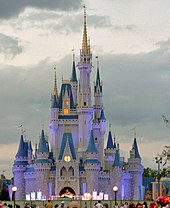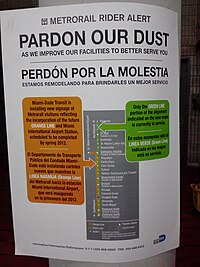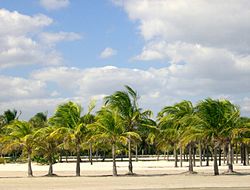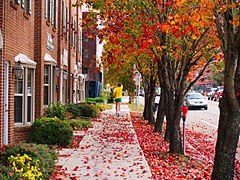The Gross Domestic Product (GDP) of Florida in 2010 was $748 billion.[165] Its GDP is the fourth largest economy in the United States.[166] In 2010, it became the fourth largest exporter of trade goods.[167] The major contributors to the state's gross output in 2007 were general services, financial services, trade, transportation and public utilities, manufacturing and construction respectively. In 2010–11, the state budget was $70.5 billion, having reached a high of $73.8 billion in 2006–07.[168] Chief Executive Magazine name Florida the third "Best State for Business" in 2011.[169]
The economy is driven almost entirely by its nineteen metropolitan areas. In 2004, they had a combined total of 95.7% of the state's domestic product.[170]
Personal income
See also: Florida locations by per capita income
In 2011, Florida's per capita personal income was $39,563, ranking 27th in the nation.[171] In February 2011, the state's unemployment rate was 11.5%.[172] Florida is one of seven states that do not impose a personal income tax.Florida's constitution establishes a state minimum wage that (unique among minimum wage laws) is adjusted for inflation annually. As of January 1, 2015, Florida's minimum wage was $5.03 for tipped positions, and $8.05 for non-tipped positions, which was higher than the federal rate of $7.25.[173]
Florida has 4 cities in the top 25 cities in the U.S. with the most credit card debt.[174] The state also had the second-highest credit card delinquency rate, with 1.45% of cardholders in the state more than 90 days delinquent on one or more credit cards.[175]
There were 2.4 million Floridians living in poverty in 2008. 18.4% of children 18 and younger were living in poverty.[176] Miami is the sixth poorest big city in the United States.[177] In 2010, over 2.5 million Floridians were on food stamps, up from 1.2 million in 2007. To qualify, Floridians must make less than 133% of the federal poverty level, which would be under $29,000 for a family of four.[178]
Real estate
In the early 20th century, land speculators discovered Florida, and businessmen such as Henry Plant and Henry Flagler developed railroad systems, which led people to move in, drawn by the weather and local economies. From then on, tourism boomed, fueling a cycle of development that overwhelmed a great deal of farmland.Because of the collective effect on the insurance industry of the hurricane claims of 2004, homeowners insurance has risen 40% to 60% and deductibles have risen.[59]
At the end of the third quarter in 2008, Florida had the highest mortgage delinquency rate in the U.S., with 7.8% of mortgages delinquent at least 60 days.[175] A 2009 list of national housing markets that were hard hit in the real estate crash included a disproportionate number in Florida.[179] The early 21st-century building boom left Florida with 300,000 vacant homes in 2009, according to state figures.[180] In 2009, the US Census Bureau estimated that Floridians spent an average 49.1% of personal income on housing-related costs, the third highest percentage in the U.S.[181]
In the third quarter of 2009, there were 278,189 delinquent loans, 80,327 foreclosures.[182] Sales of existing homes for February 2010 was 11,890, up 21% from the same month in 2009. Only two metropolitan areas showed a decrease in homes sold: Panama City and Brevard County. The average sales price for an existing house was $131,000, 7% decrease from the prior year.[183][dubious ]
Tourism
The Port of Miami is the world's largest cruise ship port.
Walt Disney World Resort in Orlando.
If you can't find something to do in Florida, you're just boring...Tourism makes up one of the largest sectors of the state economy, with nearly 1.4 million persons employed in the tourism industry in 2016 (a record for the state, surpassing the 1.2 million employment from 2015).[185][186] In 2015, Florida broke the 100-million visitor mark for the first time in state history by hosting a record 105 million visitors[186][187] and broke that record in 2016 with 112.8 million tourists; Florida has set tourism records for six consecutive years.[185]
Many beach towns are popular tourist destinations, particularly during winter and spring break. Twenty-three million tourists visited Florida beaches in 2000, spending $22 billion.[188] The public has a right to beach access under the public trust doctrine, but some areas have access effectively blocked by private owners for a long distance.[189]
Amusement parks, especially in the Greater Orlando area, make up a significant portion of tourism. The Walt Disney World Resort is the most visited vacation resort in the world with over 50 million annual visitors, consisting of four theme parks, 27 themed resort hotels, 9 non–Disney hotels, two water parks, four golf courses and other recreational venues.[190] Other major theme parks in the area include Universal Orlando Resort, SeaWorld Orlando and Busch Gardens Tampa.
Agriculture and fishing
Oranges in Florida.
Citrus canker continues to be an issue of concern. From 1997 to 2013, the growing of citrus trees has declined 25%, from 600,000 acres (240,000 ha) to 450,000 acres (180,000 ha). Citrus greening disease is incurable. A study states that it has caused the loss of $4.5 billion between 2006 and 2012. As of 2014, it was the major agricultural concern.[192]
Other products include sugarcane, strawberries, tomatoes and celery.[193] The state is the largest producer of sweet corn and green beans for the U.S.[194]
The Everglades Agricultural Area is a major center for agriculture. The environmental impact of agriculture, especially water pollution, is a major issue in Florida today.
In 2009, fishing was a $6 billion industry, employing 60,000 jobs for sports and commercial purposes.[195]




















